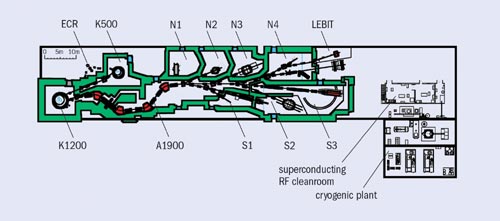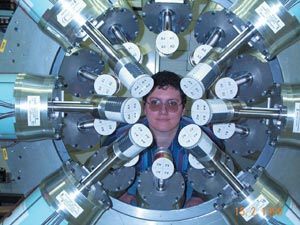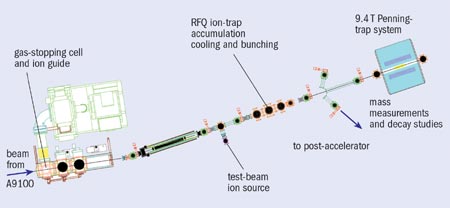Since it was founded in the 1980s, Michigan State University’s National Superconducting Cyclotron Laboratory has evolved to become the US’s premier rare-isotope facility. Georg Bollen reports on its varied activities.

The National Superconducting Cyclotron Laboratory (NSCL) is a rare-isotope facility at Michigan State University (MSU) in the US. Since it started operating as a user facility in the late 1980s, the NSCL has established a successful history of research in nuclear physics. The facility has been extended and upgraded several times including a major upgrade from 1999 to 2001. This has dramatically improved the number and intensity of rare-isotope beams that the facility can provide, and has made the NSCL the premier rare-isotope user facility in the US.
The upgraded NSCL facility is based on two coupled superconducting cyclotrons and can produce intense energetic beams of primary heavy ions from hydrogen to uranium. A high-acceptance fragment separator allows efficient production and the in-flight separation of a broad range of secondary rare-isotope beams produced by projectile fragmentation or fission reactions. These beams are sent to various experimental devices that serve a community of researchers from the US and abroad.
Research at the NSCL is devoted to experimental and theoretical nuclear physics, nuclear astrophysics, accelerator physics and the development of related instrumentation. A key activity is investigating the properties of rare isotopes that are far away from stability. This includes measuring the structural and decay properties of nuclei near the drip lines; determining astrophysically important data on neutron- and proton-rich nuclei that participate in the r and rp (rapid neutron and proton capture) nucleosynthesis processes; and measuring mass precisely. Furthermore, beams at the NSCL allow the creation of nuclei at temperatures and densities commensurate with the liquid-gas phase transition in the phase diagram of nuclear matter. Here, the NSCL’s research addresses questions concerning the thermodynamics of strongly interacting quantum many-body systems, and especially the determination of the equation of state of asymmetric nuclear matter.
Technical innovation

The NSCL has a history of technical innovation. It has been a pioneer in applying superconducting magnet technology to the design and construction of cyclotrons, spectrographs and beam-transport systems. The NSCL designed, built and commissioned the first superconducting cyclotron for cancer therapy by neutron irradiation at Harper Hospital in Detroit. Today, the NSCL’s conceptual design for a superconducting 250 MeV proton cyclotron is the basis of the proton-therapy facility at the Paul Scherrer Institut which is being built by ACCEL with technical assistance from the NSCL. Perhaps the most important new initiative is the development of superconducting radiofrequency structures for use in linear accelerators. These structures may be used in the next-generation rare-isotope beam facility Rare Isotope Accelerator (RIA). RIA is now the highest new-construction priority of the US nuclear-physics community. NSCL played a key role in developing the RIA concept and MSU is naturally one of the prime candidate sites.
Rare-isotope production at the NSCL starts with a set of electron cyclotron resonance (ECR) ion sources (figure 1) that can ionize essentially any chemical element. Multiply-charged ions are injected into the first of NSCL’s two cyclotrons, the K500. Here the ions are accelerated to an energy of about 10 MeV per nucleon and sent to the K1200 cyclotron. Inside the K1200 the ions pass a stripper foil that removes most – and, in the case of light elements, all – electrons. In this way maximum beam energies of 200 MeV per nucleon for lighter elements and 90 MeV per nucleon for uranium are achieved after final acceleration. These energetic primary beams can be used directly in experiments, or they can be converted into a broad range of radioactive ions by impinging them onto a thin target, where the choice of material and thickness optimizes the production of the desired isotopes.
To become useful for experiments the rare isotopes produced by projectile fragmentation or fission reactions have to be mass separated. This happens in the A1900 fragment separator/beam analysis system. The techniques used in the A1900 are so sensitive that one nucleus out of 1018 can be selected and studied. The A1900 can also be used as a monochromator to define the energy and emittance of the primary beam. Downstream from the A1900 is a beam switchyard that allows all the radioactive ion beams to be transported to any experimental station at the NSCL.

The facility’s scientific reach is determined by the predicted intensities after separation in flight with the A1900 (figure 2). Far away from the valley of stability such predictions can be very uncertain. Nevertheless, the figure gives an idea about what will be in reach. For orientation, the approximate paths of nucleosynthesis via the astrophysical rapid proton (rp) and rapid neutron (r) processes are indicated. With beams from the CCF it may be possible to extend our knowledge of the neutron drip line (nucleons with a large number of neutrons) from oxygen to silicon or even sulphur. It will be possible to study a large number of rp-process nuclei and r-process nuclei up to A = 140, and at the same time to explore how nuclear structure evolves as one recedes to the borderlines of nuclear stability.
Experimental devices

The largest experimental device connected to the NSCL beam-line system is the S800 (figure 3). This is a superconducting magnetic spectrograph well matched to reaction studies with rare isotopes. It offers high-energy resolution (E/DE = 104), large momentum acceptance (Dp/p = 5%) and a large solid angle (Dq = 20 msr). The S800 enables various types of reaction studies to be performed with high resolution and high sensitivity. It is a key instrument for a large part of the experimental programme carried out at the NSCL.
The 4p array is a low-threshold “logarithmic” 4p detector that has been successfully used and will be used for intermediate-energy heavy-ion collision experiments. It consists of 32 position-sensitive, parallel-plate, multiwire detectors, backed by segmented Bragg ionization chambers, backed in turn by an array of 170 so-called phoswich detectors, each consisting of a fast-slow plastic scintillator combination. Upgraded with higher-granularity forward arrays it will allow studies of collisions of very heavy systems at the higher energies now available (for example, Au + Au at E/A * 40 MeV).
In addition to this fixed major equipment, a number of special-purpose detector arrays exist for the coincident detection of g-rays, neutrons and charged particles. An important new instrument is a set of 18 segmented germanium detectors. This system has been designed for the efficient high-resolution detection of g-rays emitted in flight from fast rare isotopes, but can also be used for online decay studies. For example, it will be used in intermediate-energy Coulomb-excitation studies, which investigate the collective properties of very-neutron-rich isotopes.
The lab has a pair of large area neutron detectors, or “neutron walls”, and a third, MONA, is being constructed by a collaboration between several universities and undergraduate colleges. MONA is a modular system with a total area of 4 ms and an efficiency of about 70% for neutron energies above 50 MeV. It will be used with a large-gap superconducting “sweeper” magnet (4 Tm) that is being constructed at Florida State University’s High Magnetic Field Laboratory. The magnet will serve as a high-acceptance magnetic spectrometer and, combined with neutron detectors, will be used for neutron time-of-flight spectroscopy.

A number of experiments require high-quality low-energy beams, such as those available at CERN’s ISOLDE facility. This type of beam is not usually available at projectile-fragmentation facilities, which on the other hand do provide beams of all elements and have advantages in the production of the most short-lived isotopes. Providing such low-energy beams and making them available for experiments is the task of the Low Energy Beam and Ion Trap (LEBIT) facility (figure 4).
The key element of the LEBIT facility is a high-pressure (up to 1 bar) helium gas cell for slowing down and collecting energetic rare isotopes from the A1900 fragment separator. Ions slowed down in the gas cell remain singly charged and can be extracted with high efficiency. Electric fields guide the ions from the stopping volume through an exit nozzle into a radiofrequency quadrupole (RFQ) system that directs the ions through a differential pumping system. The continuous ion beam is then transported into a linear RFQ ion trap, which acts as a beam accumulator, cooler and buncher. The energy of the extracted ion bunches can be varied between 5 and 60 keV by means of a pulsed drift tube to satisfy the requirements of a variety of experiments. The system is in an advanced stage of construction and gas-stopping tests are under way. Experience gained in gas stopping and beam manipulation in LEBIT will provide valuable insight for the design and construction of a similar facility at RIA.

The first experiment to be set up is a Penning-trap system. A superconducting solenoid magnet with a field of 9.4 T will allow the extension of high-precision Penning-trap mass measurements to isotopes with half-lives as short as 10 ms. Later there are plans to add laser spectroscopy for isotopic-shift and nuclear-moment measurements, and atom-trap experiments for fundamental tests of weak interactions. Finally, beams from the LEBIT facility are well suited to post-acceleration to medium energies, as featured at CERN’s REX-ISOLDE. A design study for such a scenario has already been carried out.
Further reading
NSCL website at http://www.nscl.msu.edu.





